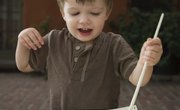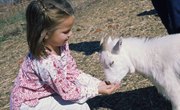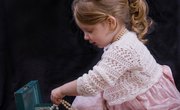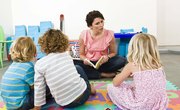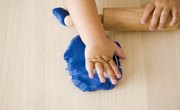It's a fun activity, for preschoolers and parents. Finding rough and smooth activities for preschool aged children can be a way to bond as well as teach a child about the wonderful world around them. Teach kids about different textures through some entertaining activities that allow them to have fun while learning. Smooth and rough or hard and soft activities give the children a hands-on experience. Encourage students to pay attention and try their best by awarding small prizes, such as stickers or pencils, for a job well done. Combining rough and smooth activities for preschool children is a relatively simple endeavor that can be done in an afternoon.
Touching for a Teachable Moment
Create an easy texture activity for children by placing several items with different textures on a table. Label each item as “smooth,” “rough,” “hard” or “soft.” Have the children touch each item to get an idea of how they feel. The children can pick up and hold the items to get a hands-on experience. Allow the children to do this activity for 10 to 15 minutes and make sure each child has a chance to touch each item. An example of hard things to touch would be seashells, smooth stones, rocks, pine cones and sandpaper. Examples of soft things would be cotton balls, and faux fur.
Sorting in Shapes and Sizes
Scatter several items with different textures on a table. Select one child to stand at the table and sort all the items by texture. He must sort the items into groups of rough, smooth, hard and soft. If he sorts all the items correctly, reward him with a small prize. Turn this activity into a game by creating two tables with identical items. Have two children stand at the tables and compete to see who can sort the items in the fastest amount of time. Award a small prize to the winner. You can also have the children sort the items from softest to hardest or smoothest to roughest. An example of hard things to sort would be large wooden beads, rocks from the garden, plastic container lids and wooden blocks. Examples of soft objects would be pieces of felt, stress balls and stuffed animals.
Example of Hard Things
Rubbing a crayon or pencil over a hard object can open the child's imagination and sense of discovery. Place a sheet of paper on the bottom of a shoe and rub a crayon over the paper. This will leave a texture rubbing on the paper. Give each child a sheet of paper and tell them to create different texture rubbings in the classroom. Some examples include a table for a smooth surface, the floor for a hard surface, a plush toy for a soft surface and blocks for a rough surface. After each player finds all four surfaces and has their rubbings, allow them to share what they found with the class. Alternatively, take the children outside to find the textured items. An example of hard things can include raised logos on plastic toys, zippers or the covers of board books.
Matching for Motor Skills
Create a matching game with textures, either indoors or outdoors. Have each child feel an item with a certain texture, such as smooth, and then match it. If they feel a plush animal, for example, they must all find something else in the classroom with the same texture. For example, they could find a soft jacket or a cotton ball. If you take the children outdoors, allow them to feel a twig with a rough texture. They must then find something else with a rough texture, such as tree bark or a rough-textured rock. Each time a child brings you an item with a matching texture, reward her with a small prize. This teaching tool is a great way to incorporate both rough and smooth activities for preschool aged children. Examples of soft objects with interesting textures include pom-poms, feathers and puffy stickers.



